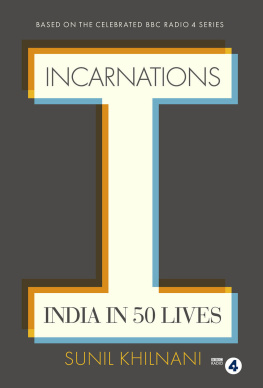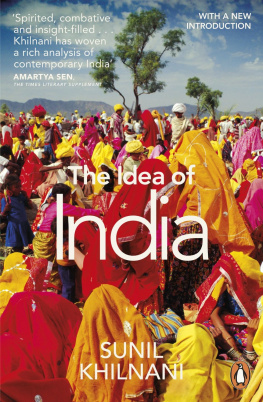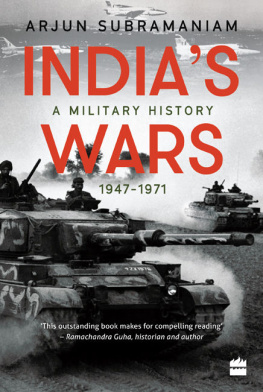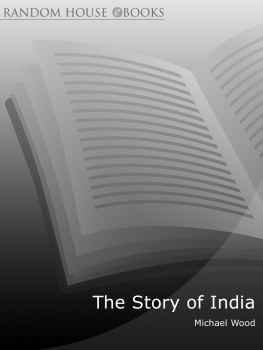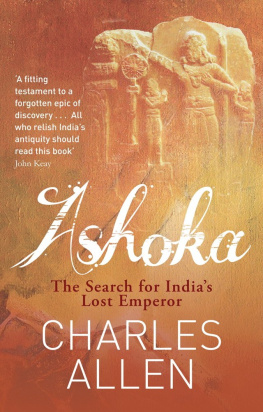Sunil Khilnani
INCARNATIONS
India in 50 Lives
Contents
For
Uma
Khemchand
Clinton
and for
Katherine
*
Incarnators all
Fifty Lives: Birthplaces
List of Illustrations
Every effort has been made to contact all copyright holders. The publishers will be happy to correct in future editions any errors or omissions brought to their attention.
The endpapers show a statue park in Hyderabad, 2015. Photos: Sunil Khilnani.
Introduction
Indias history is a curiously unpeopled place. As usually told, it has dynasties, epochs, religions and castes but not many individuals. Beyond a few iconic names, most of the important historical figures recede into a haze, both for people outside India and for many Indians themselves. Incarnations is an experiment in dispelling some of the fog by telling Indias story through fifty remarkable lives.
The essays in this book move headlong across 2,500 years of history, from the political and moral preoccupations of Indias earliest historical personality, the Buddha, to the late twentieth-century capitalist imagination of the industrialist Dhirubhai Ambani. On the way, we meet kings, religious thinkers and freedom fighters, as well as poets, painters, mathematicians and radical social reformers.
Jawaharlal Nehru famously described this past as a palimpsest, where each successively dominant culture, religion or group left its traces, never quite effacing what came before it. It is a beautiful image, evocative of the countrys deep civilizational stratigraphy, but Ive come to think of it as too passive. To me, Indias past is an arena of ferocious contest, its dead heroes continually springing back to life and despatched to the frontlines of equally ferocious contemporary cultural and political battles. So this book is also concerned with the afterlives of historical figures: the often intriguing ways in which they are put to later use by government officials, entrepreneurs or tribal leaders across the Indian interior, or in physics labs, health clinics, hip-hop tracks and yoga studios across the East and West.
The subcontinent on which these stories unfold is the only place where each of the worlds four great religions Hinduism, Buddhism, Christianity and Islam has at different times ruled large areas. Through religious collisions and philosophical and ethical explorations, many of the individuals in this book were part of intense arguments that have been kept going for millennia: about what kind of life is worth living, what kind of society is worth having, which hierarchies are morally legitimate, what role religion has in the political and legal order and what kind of place India should be.
Such arguments have kept India in a permanent and, on balance, productive state of openness about what the country and its people are. A civilization able to produce a Mahavira, a Mirabai, a Malik Ambar, a Periyar, a Muhammad Iqbal and a Mohandas Gandhi is a place open to radical experiments with self-definition. It is particularly worth recalling that history and creative energy at a moment when some in India seek to transform the ferment of ideas over what India is and should be into a singular religious concoction.
Of course, much still remains unknown and disputed about Indian history, especially for the period before 1000 CE . About the lives of Indian women, apart from a few queens, the records are distressingly sparse right through to the twentieth century. Even now, much of Indias history is endangered: some of who we were and what weve done sits in uncatalogued heaps, often in languages few still know. And yet in the past few decades weve made significant advances in our ability to make sense of the Indian past, through developments in archaeology, philosophy, mathematics, art history and literature. I draw on this important work as I try to track the fifty figures in this book: to see how they navigated the intellectual confluences and the practical constraints of their times, and made choices that changed, in small and large and sometimes unintended ways, the circumstances of the figures who succeeded them.
Many of the essays in Incarnations are driven by arguments, ranging from the nature of power to how to live a healthy life to the conditions of individual liberty. Heres one argument to start with: that Indias non-fictional past is sufficiently complex, unexpected and rich in inspiring example that fictionalized heroes are a little redundant. By insisting that figures from Indias past be preserved in memory as saints, above human consideration, we deny them not just their real natures, but their genuine achievements.

If you dont yet know the arresting stories behind some of the names Ive mentioned (say, Malik Ambar, a gifted seventeenth-century Abyssinian slave turned Deccan warrior-king) or others youll encounter in this book (such as Chidambaram Pillai, a dogged Tamil nationalist who took on the steamship might of the British Empire), that is perhaps not accidental. Who gets remembered, how history is told, and who gets to tell it are all matters of political dispute in India. Some historical icons are so staunchly defended against scrutiny that libraries whose collections have enabled scholars to write about those icons have been attacked. Books thought insufficiently reverent towards cherished figures are pulped and banned, their authors threatened, silenced, or worse.
As I chased down often-elusive lives in far-flung communities, in archives and in texts, I sometimes found an absurd gap between the superhero guises that some figures are forced to don today and the searching, self-critical natures that animated them in their own lifetimes. The impulse to make Indian historical lives exemplary and didactic goes back a long way right back to the Buddha, at least. Its an ahistorical habit of mind mirrored by those who exalt Indias culture as ineffable and spiritual something that turns out to go back quite a long way, too.
British imperialists liked to suggest Indians were indifferent to their history (and inept at independent thinking to boot) because of their attachment to doll-like gods and caste rituals. Indians saw things differently, of course: the colonizers had pillaged the subcontinents historical resources with the same voraciousness as they had plundered the teakwood and tea, unmooring their subjects from their traditions and pasts. Beginning in Bengal after the turn of the twentieth century, successive generations of nationalists struggled to gain control of their own history. And after Independence was won, in 1947, a host of long-suppressed claimants regions, castes, religious communities pushed for the primacy of their own favourite leaders within a new Indian pantheon. One of the most predictable acts of newly elected state or national governments was and is to rewrite history textbooks to their liking. The countrys current ruling ideology aspires to define India as a Hindu nation, and to endow it with appropriately Hindu antecedents, with the inevitable simplifications that involves.

